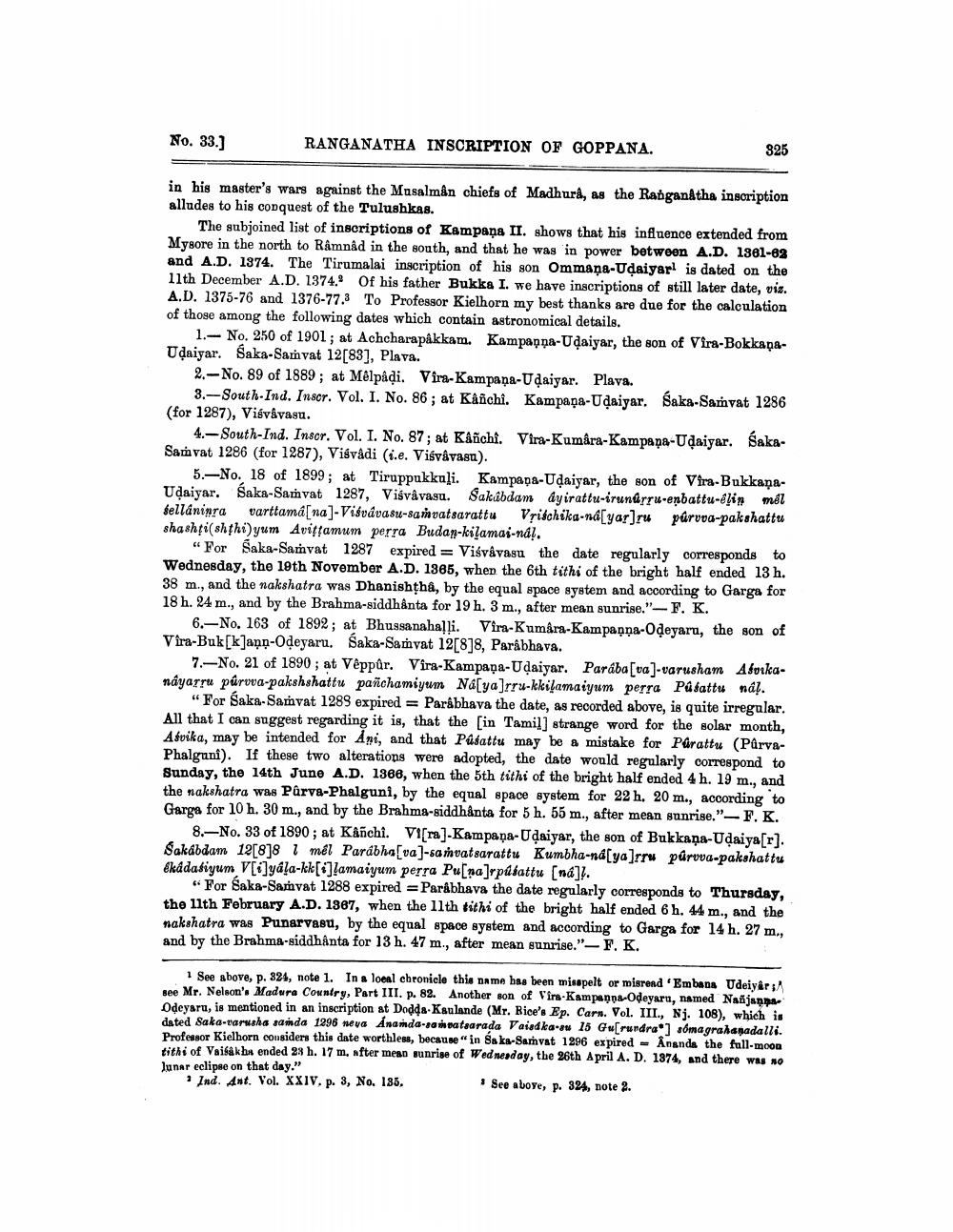________________
No. 33.]
RANGANATHA INSCRIPTION OF GOPPANA.
825
in his master's wars against the Masalmân chiefs of Madhura, as the Ranganatha inscription alludes to his conquest of the Tulushkas.
The subjoined list of inscriptions of Kampaņa II. shows that his influence extended from Mysore in the north to Rämnad in the south, and that he was in power between A.D. 1961-62 and A.D. 1974. The Tirumalai inscription of his son Ommaņa-Udaiyarl is dated on the 11th December A.D. 1374. Of his father Bukka I. we have inscriptions of still later date, viz. A.D. 1375-76 and 1376-77.3 To Professor Kielhorn my best thanks are due for the calculation of those among the following dates which contain astronomical details.
1.- No. 250 of 1901 ; at Achcharapakkam. Kampanna-Udaiyar, the son of Vira-BokkapaUdaiyar. Saka-Samvat 12[83], Plava.
2.-No. 89 of 1889; at Mélpadi. Vira-Kampaņa-Udaiyar. Plava.
3.-South-Ind. Insor. Vol. I. No. 86 ; at Kanchi. Kampaņa-Udaiyar, Saka-Samvat 1286 (for 1287), Visvävasu.
4.-South-Ind. Insor. Vol. I. No. 87; at Kånchi. Vira-Kumâra-Kampaņa-Udaiyar. SakaSamvat 1286 (for 1287), Viśvadi (i.e. Viśvâvasu).
5.-No. 18 of 1899; at Tiruppukkali. Kampada-Udaiyar, the son of Vira-BukkaņaUdaiyar. Saka-Samvat 1287, Viśvâvagu. Sakábdam dyirattu-irundrru-enbattu-elin mél felláninra varttama[na]-Visvavasu-sanvatsarattu Vrischika-násyar]ru purvua-pakshattu shashishthiyum Avittamum perra Budap-kilamaj-nap.
"For Saka-Samvat 1287 expired = Visvavagu the date regularly corresponds to Wednesday, the 19th November A.D. 1965, when the 6th tithi of the bright half ended 13 h. 38 m., and the nakshatra was Dhanishthâ, by the equal space system and according to Garga for 18 h. 24 m., and by the Brahma-siddhanta for 19h. 3 m., after mean sunrise." - F. K.
6.-No. 163 of 1892; at Bhussanahaļļi. Vira-Kumâra-Kampaņņa-Odeyaru, the son of Vira-Buk[k]ann-Odeyaru. Saka-Samvat 12[8]8, Parabhava.
7.-No. 21 of 1890; at Véppúr. Vira-Kampaņa-Udaiyar. Parába[va] -varusham Afurkanayarru púruva-pakshshattu pañchamiyum Na[ya]rrz-kkilamaiyum perra Padattu náļ.
"For Saka-Samvat 1289 expired = Parkbhava the date, as recorded above, is quite irregular. All that I can suggest regarding it is, that the [in Tamil] strange word for the solar month, Afvika, may be intended for Ani, and that Pusattu may be a mistake for Párattu (PärvaPhalguni). If these two alterations were adopted, the date would regularly correspond to Sunday, the 14th June A.D. 1366, when the 5th tithi of the bright half ended 4 h. 19 m., and the nakshatra was Pârva-Phalguni, by the equal space system for 22 h. 20 m., according to Garga for 10 h. 30 m., and by the Brahma-siddhanta for 5 h. 55 m., after mean sunrise."- F. K.
8.-No. 33 of 1890 ; at Kanchi. Vi[ra]-Kampaņa-Udaiyar, the son of Bukkaņa-Udaiya[r]. Sakábdam 12[8]81 mêl Parábha [va)-samvatsarattu Kumbha-ná[ya]rru púrova-pakshattu Ekadasiyum V[i]yáļa-kk[]lamaiyum perra Pu[na]rpdbattu (ná]!.
“For Saka-Samvat 1288 expired =Parabhava the date regularly corresponds to Thursday, the 11th February A.D. 1867, when the 11th tithi of the bright half ended 6 h. 44 m., and the nakshatra was Punarvasu, by the equal space system and according to Garga for 14 h. 27 m., and by the Brahma-siddhanta for 13 h. 47 m., after mean sunrise." - F. K.
1 See above, p. 324, note 1. In a local chronicle this name has been misspelt or misrend 'Embana Udeiyar see Mr. Nelson's Madura Country, Part III. p. 82. Another son of Vira-Kampagna-Odeyara, named Naijanna. Odeyaru, is mentioned in an inscription at Dodda-Ksulande (Mr. Rice's Ep. Carn. Vol. III., Nj. 108), which is dated Saka-rarusha saída 1296 seva Ananda-sanatsarada Vaiadka-su 15 Gu[rundra'] sómagrahagadalli. Professor Kielhorn considers this date worthless, because" in Sa ka-Samvat 1296 expired - Ananda the full-moon tithi of Vaisakhn ended 38 h. 17 m, after mean sunrise of Wednesday, the 26th April A. D. 1874, and there was no lunar eclipse on that day." * Ind. Ant. Vol. XXIV. p. 3, No. 135.
* See above, p. 324, note 2.




